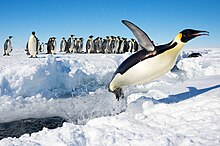Luitpold Coast

Luitpold Coast (
Filchner Ice Shelf. It was discovered by Wilhelm Filchner, leader of the Second German Antarctic Expedition, 1911–12, and named after Luitpold, Prince Regent of Bavaria.[1]
Important Bird Area
A 500 ha site on fast ice some 50 km north-east of the
Filchner Ice Shelf, where icebergs regularly calve from the continental margin, has also been designated an Important Bird Area (IBA) by BirdLife International because it supports a breeding colony of about 6,500 emperor penguins, an estimate based on 2009 satellite imagery.[2]
Virgen de las Nieves Refuge
Virgen de las Nieves Refuge (79°10′00″S 38°53′00″W / 79.166667°S 38.883333°W) is an Argentine Antarctic refuge located on the
Filchner-Ronne Ice Shelf on the Luitpold Coast 150 kilometres south of the Belgrano I Base. The refuge is administered by the Argentine Army
and was opened on 2 December 1958 and is under the base Belgrano II.
The refuge was built in the Argentine Antarctic campaign of 1958–1959 under the supervision of Lieutenant Colonel Jorge De Marzi and Major Pedro Arcondo. At the time, it was the southernmost Antarctic refuge of Argentina, more to the south of Refuge Santa Bárbara and the old Sobral Base. The name of the refuge refers to Our Lady of the Snows.[citation needed]
See also
References
- ^ "Luitpold Coast". Geographic Names Information System. United States Geological Survey, United States Department of the Interior. Retrieved 8 July 2013.
- ^ "Luitpold Coast". BirdLife Data Zone. BirdLife International. 2015. Retrieved 14 November 2020.
External links
 This article incorporates public domain material from "Luitpold Coast". Geographic Names Information System. United States Geological Survey.
This article incorporates public domain material from "Luitpold Coast". Geographic Names Information System. United States Geological Survey.
77°30′S 32°0′W / 77.500°S 32.000°W


